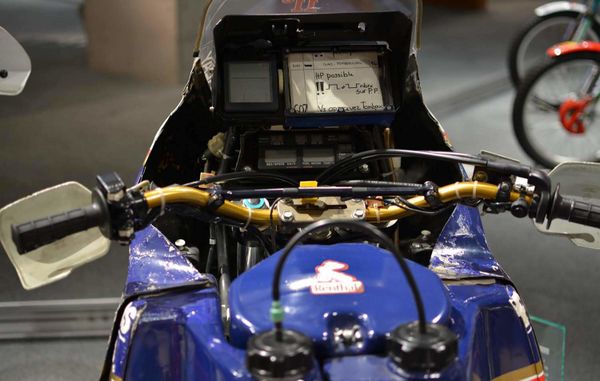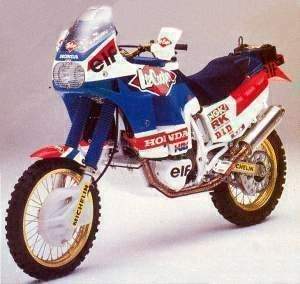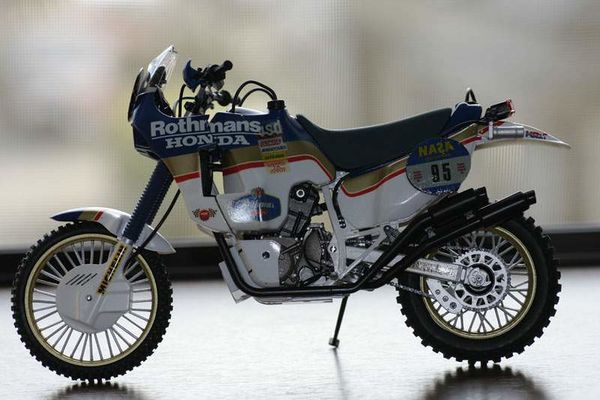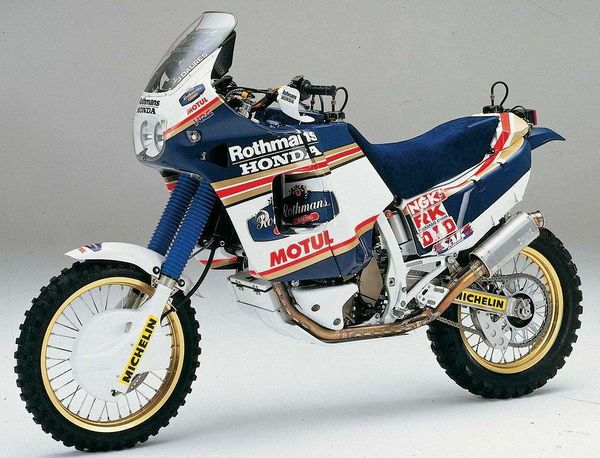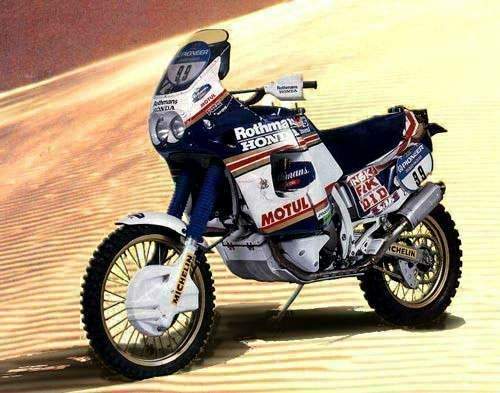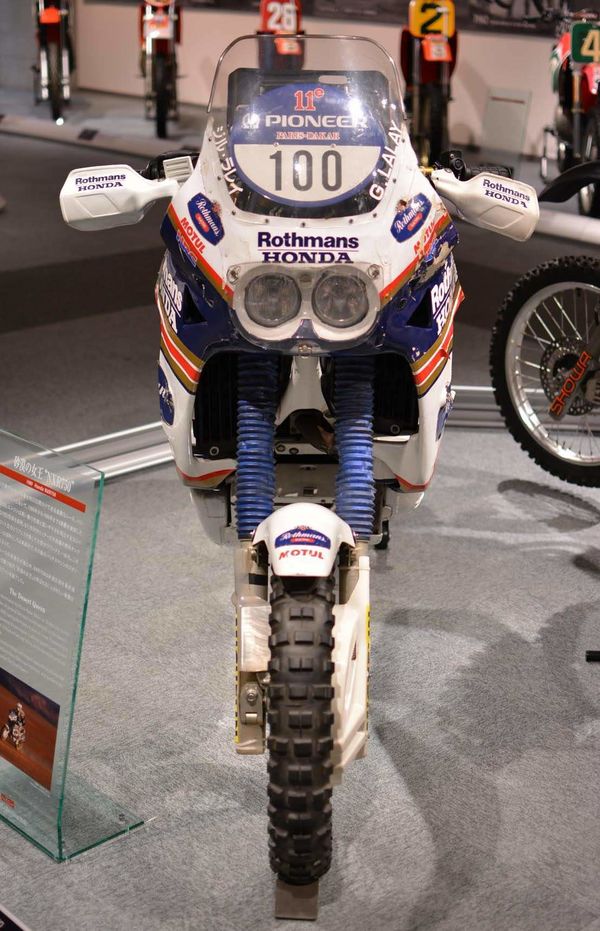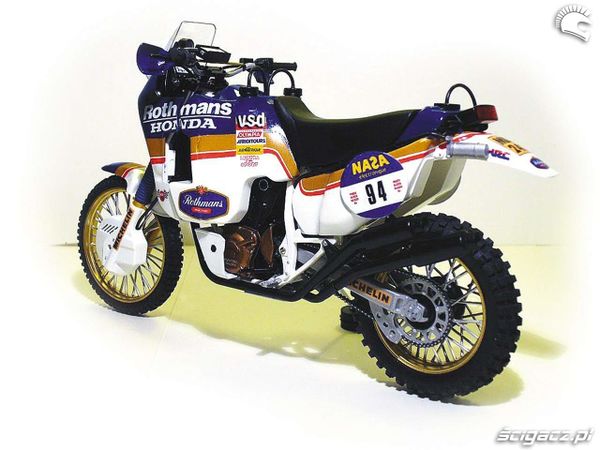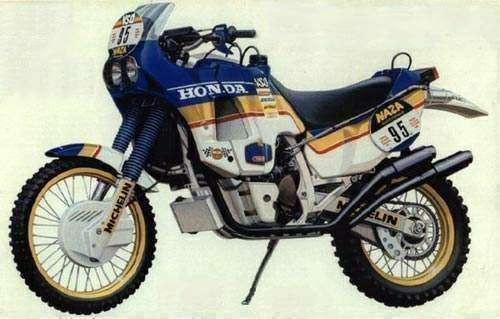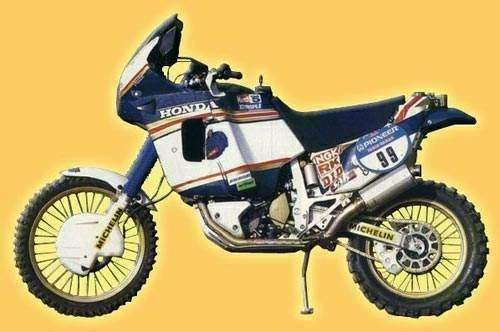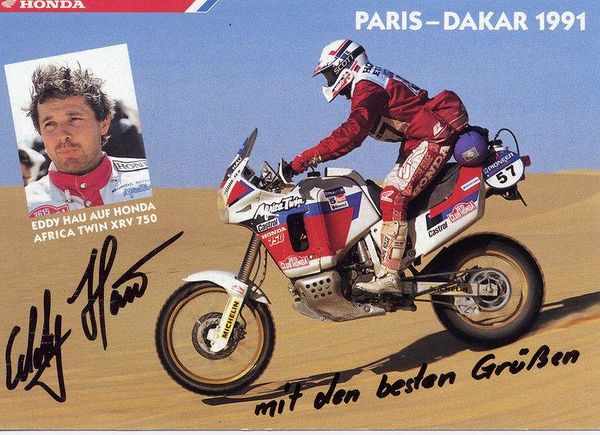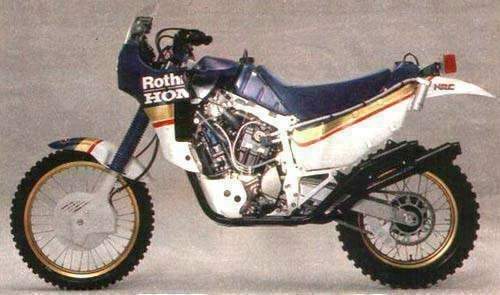Honda XR750 Dakar
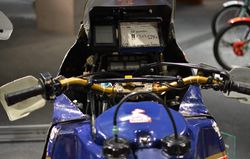 |
|
| Honda XR750 Dakar | |
| Manufacturer | |
|---|---|
| Production | 1987 - 90 |
| Class | Trail |
| Engine | Four stroke, 52° V-twin cylinder, OHC, 4 valves per cylinder |
| Ignition | CDI |
| Transmission | 6 Speed |
| Suspension | Front: Telescopic forks, 220 mm wheel travel Rear: Pro-link, Swinging arm, 210 mm wheel travel |
| Brakes | Front: 276 mm Single disc Rear: 256 mm Single disc |
| Front Tire | 90/90 -21 |
| Rear Tire | 130/90 -17 |
| Weight | |
| Recommended Oil | Honda GN4 10W-40 |
| Fuel Capacity | 24 Liters / 6.3 US gal |
| Manuals | Service Manual |
Engine[edit | edit source]
The engine was a Liquid cooled cooled Four stroke, 52° V-twin cylinder, OHC, 4 valves per cylinder.
Chassis[edit | edit source]
It came with a 90/90 -21 front tire and a 130/90 -17 rear tire. Stopping was achieved via 276 mm Single disc in the front and a 256 mm Single disc in the rear. The front suspension was a Telescopic forks, 220 mm wheel travel while the rear was equipped with a Pro-link, Swinging arm, 210 mm wheel travel. The XR750 Dakar was fitted with a 24 Liters / 6.3 US gal fuel tank.
Photos[edit | edit source]
Overview[edit | edit source]
H
onda NXR 750 Dakar
Competitors in the eighth Paris-Dakar Rally headed south into the wilds of the Sahara desert, struggling over the dunes in search of glory in this torturing rally that lasts more than 20 days and approximately 14,000km. Automotive manufacturers taking part in this renown rally concentrate on reliability of the machine, which is more of an asset than speed. Honda will remember the 1986 Paris-Dakar Rally for their victory in the two wheel category with the NXR 750 desert racer. Cyril Neveu came through the sea of sand riding on this superlative hi-tech rally machine, to reach the exotic shores of Senegal, making history as the first ever, liquid cooled engine powered motorcycle to win this rally.
The history making four valve, SOHC, V twin cylinder
liquid cooled engine has a displacement of 779cc, and produces more than 70
horse power. This racer was developed exclusively for the Paris-Dakar Rally by
the Honda Racing Corporation, better known as HRC, who are renown for producing
many record breaking/legend making racers. Their painstaking endeavors are
apparent in the NXR's slim, low center of gravity concept configuration. The
dual headlights and cowling are rarely seen on these off road type motorcycles
and they stood out as it sped through the heat waves of the Sahara.
The story begins, in the year 1984, when HONDA gave the âgreen
lightâ to the HRC to develop, manufacture and evolve a motorcycle
with racing specifications in order to get into the âlong distance
raceâ arena. This decision was not taken by chance, but in
accordance to the motorcycle-market attitude of the early 80s. The
long distance off-road races, were enjoying great popularity, which
got spread beyond those, who were directly involved to them. The
reason for this popularity was an event, which was commencing from
Paris and ending to Dakar/Senegal, crossing the African desert. In a
few years Paris â Dakar became a myth in the motorcyclist world and
even further.
The first Paris â Dakar rally took place in 1979 and its popularity launched the off-road motorbike sales (bigger than 125cc) to 3.8 times more, in the period 1980-1987. The motorcycles with long suspension and bulky fuel tanks, established a new fashion. The essential factor for this new fashion was based on purely practical grounds. It is the simplicity of the single or twin cylinder engine and the subsequent low maintenance cost.
All the manufacturers, perceived the perspectives of this evolving market, pretty soon and the result was the production of several series of âRally â Replicaâ models, having big tanks, various easements for the rider - like electric starter - and a fashionable appearance. Honda, as the market leader, decided the involvement of the HRC to the category, aiming to be a technological pioneer in this field, which, in return, would have a positive effect on the sales. At that time the number one in the category was the BMW, until the mid 80s, when managed to win the motorcycle world, by finishing in the first place at Paris â Dakar, at 1985 and 1986. At the 1986 Paris â Dakar, Honda finally did brake the monopoly of BMW with the brand new NXR 750 and not only won the race, but also the advance technological impressions, due to the fact that the NXR was the first water-cooled motorcycle that ever won at Paris â Dakar. This advance technology dominated the Paris â Dakar for four years in a raw, 1986, 87, 88 and 1989. Of course this was also the result of having the best riders of the particular category. In the first two years the first place was taken by Cyril Neveu, who was a myth in this field and who had already won the first race in 1979, with a Yamaha of a single cylinder. At 1988 the winner was Eddi Orioki and 1989, G. Lalay. by Rough Crafts
| Make Model | Honda NXR750 Dakar |
|---|---|
| Year | 1987 - 90 |
| Engine Type | Four stroke, 52° V-twin cylinder, OHC, 4 valves per cylinder |
| Displacement | 743 cc / cu-in |
| Bore X Stroke | 81 x 72 mm |
| Compression Ration | 9.0:1 |
| Cooling System | Liquid cooled |
| Induction | 35.6 mm Keihin CV carburators |
| Ignition | CDI |
| Starting | Electric |
| Max Power | 61.4 hp / 45.7 kW @ 7500 rpm |
| Max Torque | 80 Nm / 59 lb-ft @ 5500 rpm |
| Transmission | 6 Speed |
| Final Drive | Chain |
| Front Suspension | Telescopic forks, 220 mm wheel travel |
| Rear Suspension | Pro-link, Swinging arm, 210 mm wheel travel |
| Front Brakes | 276 mm Single disc |
| Rear Brakes | 256 mm Single disc |
| Front Tire | 90/90 -21 |
| Rear Tire | 130/90 -17 |
| Weight | 192 kg / 423 lbs |
| Fuel Capacity | 24 Liters / 6.3 US gal |
| Review | Motosprint 1990 |
